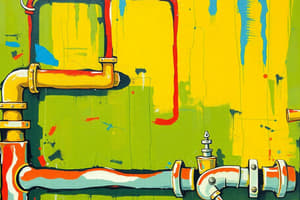Podcast
Questions and Answers
Large public ______ were developed in the 1500’s.
Large public ______ were developed in the 1500’s.
latrines
The modern ______ system was introduced in the 1860’s.
The modern ______ system was introduced in the 1860’s.
sewage
All human habitation must supply clean and wholesome ______.
All human habitation must supply clean and wholesome ______.
water
The Latin word 'plumbum' refers to the common metallic element ______.
The Latin word 'plumbum' refers to the common metallic element ______.
Backflow or backsiphonage should be prevented to ensure that dirty waters do not intersect with clean ______.
Backflow or backsiphonage should be prevented to ensure that dirty waters do not intersect with clean ______.
One of the oldest artifacts unearthed was a copper pipe used in a ______ system.
One of the oldest artifacts unearthed was a copper pipe used in a ______ system.
Plumbing fixtures shall be designed to use the minimum quantity of water consistent with proper ______ and cleaning.
Plumbing fixtures shall be designed to use the minimum quantity of water consistent with proper ______ and cleaning.
Devices for heating and storing water shall be designed to prevent danger from ______ through overheating.
Devices for heating and storing water shall be designed to prevent danger from ______ through overheating.
Around 2,500 BC, Egyptians developed copper pipes for ______ and sewerage systems.
Around 2,500 BC, Egyptians developed copper pipes for ______ and sewerage systems.
Every building having plumbing fixtures installed and intended for human habitation must have a connection with the public ______.
Every building having plumbing fixtures installed and intended for human habitation must have a connection with the public ______.
Flashcards are hidden until you start studying
Study Notes
Plumbing Overview
- Plumbing is the art and science of creating and maintaining sanitary conditions within buildings.
- Involves the installation, repair, and servicing of pipes, fixtures, and appurtenances related to water systems.
Historical Context
- Large public latrines developed in the 1500s, often built with marble.
- Water closet innovation emerged in the mid-1800s.
- Septic tanks were introduced in the 1860s, marking significant advancements in sewage management.
- Ancient civilizations like Egyptians used copper pipes for irrigation and sewage systems around 2,500 BC.
- The Roman Empire (500 BC - 455 AD) saw extensive plumbing innovations, including aqueducts and public baths.
Basic Plumbing Principles
- Water Supply: Clean and wholesome water must be supplied without contamination from dirty water.
- Volume and Pressure: Fixtures must receive sufficient water volume and pressure for proper function and minimal noise.
- Water Conservation: Fixtures should minimize water use while maintaining performance.
- Safety in Design: Heating and storing devices need to prevent explosion risks from overheating.
- Connection to Public Sewers: Buildings near public sewer systems must connect to them for waste disposal.
Plumbing Fixture Requirements
- Minimum Fixtures: Each dwelling must have at least one water closet and a kitchen sink.
- Material Standards: Fixtures must be made from smooth, non-absorbent materials to prevent fouling.
- Ventilation: Fixtures must be located in well-ventilated areas.
- Drainage Design: Drainage systems must prevent fouling, clogs, and ensure adequate air circulation.
Installation and Maintenance Guidelines
- Accessibility: Fixtures should be installed for reasonable accessibility during cleaning and maintenance.
- Durability: Piping needs to be made from durable materials to ensure longevity and effectiveness.
- Water Seal Traps: Each fixture connected to the drainage system should have a water seal trap to prevent foul odors.
Environmental and Safety Regulations
- Air Circulation: Drainage systems must allow for proper air circulation to avoid siphoning issues.
- Testing for Leaks: Plumbing systems must undergo testing to detect leaks and defects.
- Waste Disposal Regulations: Waste must be treated before being discharged into the environment to prevent contamination.
- Food Safety: Protection must be in place to prevent sewage backflow from contaminating food and water supplies.
Additional Safety Measures
- Lighting and Ventilation: No water closet should be installed in inadequately lit or ventilated areas.
- Contamination Prevention: Measures must be taken to ensure that sewage does not enter food and water storage areas.
Studying That Suits You
Use AI to generate personalized quizzes and flashcards to suit your learning preferences.




